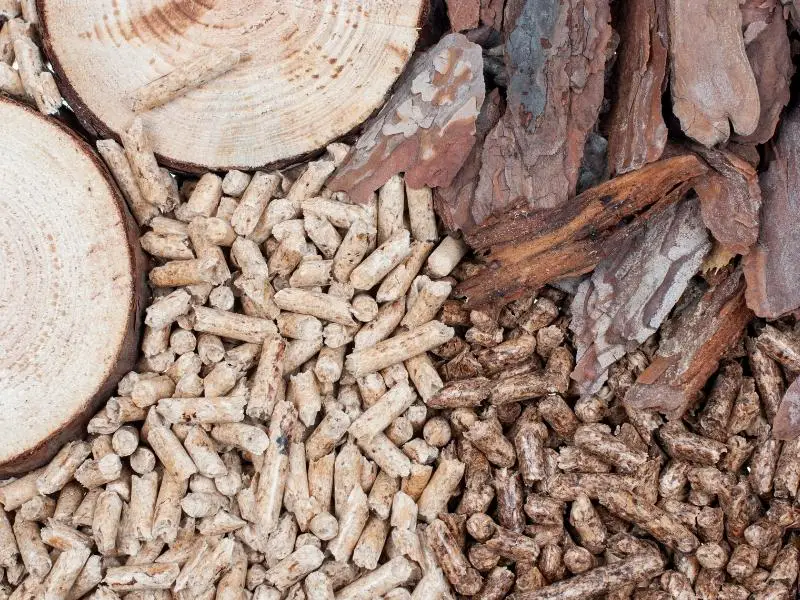Biomass is a promising alternative energy source that may be our answer to the climate crisis, but what is biomass, and what are the uses for biomass? We’ve got all the details!
- Biomass is a renewable energy source used for electricity.
- Biomass can also be used for fuel, cosmetics, food supplements, and plastics, among many other applications.
- Biomass is touted as a potential answer to the search for energy sources and could reduce our reliance on pollutive fossil fuels.
Many nations, such as the United States and the United Kingdom, have started to adopt biomass for several reasons. In this article, we’ll show you why it is becoming such a popular alternative energy source.

What Is Biomass?
Biomass refers to organic matter (from living organisms such as plants and animals) that we can use to create energy.
Since the beginning of human civilization, people have been using biomass energy, going back to our cave-dwelling days.
In other words, we can use biomass materials such as plants, wood, and waste to create energy in the same way as we have with coal and oil since the Industrial Revolution.
The energy contained in biomass is created through photosynthesis – the biological process where light rays from the sun and carbon dioxide from the earth’s atmosphere.
Theoretically, this means that the carbon emissions released from burning biomass energy sources are offset by the carbon emissions they absorb when they grow naturally.
For this reason, it is being touted as a source of renewable energy with a lot of promise, especially because it’s very cost-effective to convert old coal power stations into new, repurposed biomass power plants.
Biomass Energy Sources
Before you can understand the primary use for biomass, power generation, you first need to understand which sources we use for biomass power. Let’s take a look at the four most common biomass energy sources:
Wood & Processing Wastes
This includes sawdust from furniture and paper mills, wood chips, lumber, wood pellets, firewood, and other forms of waste produced from industrial processes that use wood.
Agricultural Crops & Waste Materials
These biomass sources include organic materials like corn, soybeans, woody plants, algae, switchgrass, sugarcane, and food and crop processing residue.
Biogenic Materials From Municipal Waste
Solid municipal waste can yield many biogenic materials such as food, wood, yard waste, paper, cotton, and wool products that we can use to create energy.
Manure & Sewerage
We can use manure and human sewerage for methane production by treating it with bacterial microorganisms, which will release biogas.
How Is Biomass Converted To Energy?
Once we have our biomass energy sources, they have to go through some complicated manufacturing processes to ensure that all of the waste is used and we yield as much energy as possible out of the source in question. Here’s a look at some of the most popular ways in which we convert biomass into energy:
Direct Combustion
Direct combustion is the most popular method of converting biomass into energy. Directly burning biomass can heat buildings and water (for steam turbines) and create the heat required for other industrial processes.
Thermochemical Conversion
Thermochemical processing involves decomposing biomass materials in closed, pressurized containers called gasifiers by heating them at high temperatures.
There are three thermochemical conversion processes, namely pyrolysis, hydrotreating, and gasification, which are distinguished from one another according to the temperatures and oxygen levels present during the process to create different byproducts.
Chemical Conversion
The chemical conversion process, also known as transesterification, converts greases, animal fats, and vegetable oils into biodiesel in the form of fatty acid methyl esters (FAME).
Biological Conversion
When biomass is converted into ethanol and renewable natural gasses, it goes through a process of fermentation. The ethanol can run motorized vehicles by processing the byproducts from dairy farms and other livestock operations.
Furthermore, we can use the human waste from sewerage treatment plants to carry out the same biological conversion process.
What Products Are Made From Biomass?
Biomass is not just used for power generation, however. We can use it to create everyday products that would otherwise be using fossil fuels in their manufacturing processes. Here are a few of the most common of them:
Biomass Can Be Used To Create Fuel
There is a good chance that, when you’re filling up at the gas station, the fuel used in your car contains ethanol. In the United States, the large volume of corn produced in the agricultural sector has created a breadbasket for biofuels already being used by the mass market today!
Biomass Can Be Used To Create Cosmetics/Perfumes
Skin cream, shampoo, mascara, and a whole range of personal care products use biomass sources during the manufacturing process. These are taken from biobased feedstocks, which create, for example, the acetone in nail polish remover or the palmitic acid that allows your conditioner to give your hair that glossy shine.
Biomass Can Be Used To Create Food Additives & Supplements
Algae is one of the most common biomass energy sources that is widely used. One acre of algae can produce up to 5,000 gallons of oil, which we can use for various things, such as renewable fuels, omega-3 fatty acids, and even flavoring agents.
Biomass Can Be Used To Create Detergents/Cleaning Products
We can convert biomass energy sources into surfactants and solvents, which are key ingredients in the cleaning agents and detergents used to clean your home, laundry.
And using biomass to create these cleaning products also makes them more biodegradable, meaning that every time you have to do some cleaning, you’re making less of an impact on the environment.
Biomass Can Be Used To Create Plastics
Traditional plastics play a huge role in the degradation of our environment and our oceans in particular, which is why the growing popularity of biobased plastics has grown exponentially in recent years. New technologies allow us to convert biomass into synthetic substances that we can use for textiles and containers for liquids.
What Are The Benefits Of Biomass?
Biomass and the destructive industrial processes that they can replace present a unique opportunity for a sustainable future in several ways. And this comes with plenty of benefits.
For example, biomass materials are widely available and renewable. This means the carbon emissions are offset by capturing carbon from Earth’s atmosphere as a natural process carried out by the living plant matter that we use in these processes.
Biomass processes also use the waste from other processes, meaning we’re not adding to our carbon footprint but are starting with energy sources that would otherwise go to waste.
And as biomass energy is becoming widely adopted, it decreases our reliance on fossil fuels. Furthermore, it is a low-cost alternative and doesn’t require a complete infrastructure overhaul like a solar or wind power migration because old fossil fuel processing plants can be repurposed to support the processes we’ve mentioned.
Finally, biomass creates an additional revenue stream for manufacturers, who can sell off their industrial waste, increase their profit margins and eventually stimulate the economy by expanding operations, creating jobs, etc. And this also means that landfill sites will not fill up as much, which will reduce pollution in general.
- Biomass explained | US Energy Information Administration
- 5 Everyday Products Made from Biomass: A Few May Surprise You | Office of Energy Efficiency & Renewable Energy
- Biomass Energy Basics | National Renewable Energy Laboratory
- Biomass energy | National Geographic
- RENEWABLE ENERGY: BIOMASS ENERGY | Young People’s Trust for the Environment
- Competing uses of biomass: Assessment and comparison of the performance of bio-based heat, power, fuels, and materials | Science Direct
- Biomass Advantages and Disadvantages | Syntech Bioenergy




